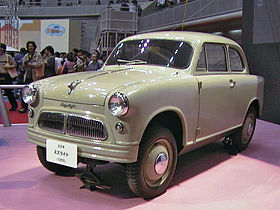Suzulight
| Suzulight | |
|---|---|
 |
|
| Overview | |
| Manufacturer | Suzuki |
| Production | October 1955-1969 |
| Assembly | Kosai Assembly Plant, Hamana-gun, Shizuoka, Japan |
| Layout | FF layout |
Suzulight was the brand used for the kei cars built by the Suzuki Motor Corporation from 1955 to 1969. They were Suzuki's first entry into automotive manufacturing, having previously only produced motorcycles. The Suzulight sedans and light vans all had transversely mounted engines and front-wheel drive. The Suzulight Carry trucks and vans were the first to use the Carry label, still around today.
Introduced in April 1955, "SF" stood for "Suzuki Four-wheel car". Work had begun in Jamuary 1954, with a front-engine, rear-wheel-drive and rear-engined design also considered. The first Suzuki was closely based on the Lloyd LP400, chosen after Suzuki also having considered the Citroën 2CV and Renault 4CV. The Suzulight SF shared the Lloyd's transversely mounted, front-wheel drive layout and the two-cylinder, two-stroke engine was a narrow-bored copy of the Lloyd's, using the same 66.0 mm (2.60 in) stroke. It had drum brakes all around, was 2,990 mm (117.7 in) long, 1,295 mm (51.0 in) wide and 1,400 mm (55.1 in) tall, with a 2,000 mm (78.7 in) wheelbase and a 1,050 mm (41.3 in) front and rear wheel track. Because of the smaller bore and resulting 359.66 cc (21.9 cu in) engine, it met the Japanese Keijidosha ("light car") legislation. It's design was by the company's founder Michio Suzuki. When introduced, the SF also had double wishbone coil-sprung suspension front and rear, with rack-and-pinion steering, features which were far ahead of their time. Just like the Lloyd which inspired it, the Suzulight featured a chassis consisting of a central tube with the suspension attached to each end of the tube.
The introduction of the Suzulight SF series also dovetailed nicely with the "People's Car Program" recently announced by Japan's Ministry of International Trade and Industry (MITI), which established a goal for the Japanese auto industry of producing "a four-seater with a top speed of 100 km/h, priced at ¥150,000," in order to speed up motorization of the country.
...
Wikipedia
